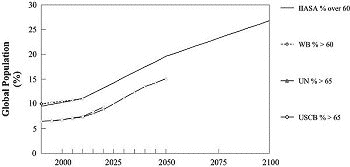|
3.2.4. Other Aspects of Population: Aging and Urbanization
3.2.4.1. Aging
|

Figure 3-6: Percentage of world
population over 60 or 65 years of age with time for the central scenarios.
The World Bank data are from 1994 (Bos et al., 1994) because the results
from 1996 are not published. The USCB data are from McDevitt (1996).
|
Population aging has widely discussed implications for social planning, health
care, labor force structural changes, and entitlement programs. As shown in
Figure 3-6, percentage growth in the elderly age cohorts
is predicted strongly by all projections. The figure shows the percentage of
elderly age cohorts using the medium projection data. Importantly, it will be
a continuous process over the entire 21st century, even though total population
size is forecast in these cases to stabilize during the latter half of the century.
The detailed economic effects of such a profound and rapid change in social
structure are not well understood (Eberstadt, 1997). The problem is considered
below in the discussion of the impact of population dynamics on economic development.
In short, conventional wisdom takes a more or less neutral view of the effect
of population growth, including the impacts of aging, on the rate of economic
growth (Hammer, 1985; Kelley, 1988; National Research Council, 1986). Lowered
population growth rates (and concomitant aging) might have a beneficial effect
on the economy through reduced youth dependency ratios, which result in higher
savings rates (Higgins and Williamson, 1997). Also, population aging could reduce
labor supply and thus reduce potential economic growth. Against this argument,
labor scarcity induces higher wages that in turn are a powerful incentive to
increase labor productivity. Increasing productivity (per capita economic output)
would balance shortfalls from possible reductions in the labor force (Disney,
1996). However, lowered fertility and mortality rates will also cause the elderly
dependency ratio to increase, which might lead to a trend of lower savings,
characteristic of elderly cohorts, which have a reduced incentive to save. In
terms of public savings, without institutional reforms aging could eventually
lead to severe strains on social security and health care programs supported
by governments and thus to reduced governmental savings (US Council of Economic
Advisors, 1997).
Interestingly, a case has been made that aging may have significant impacts
on future CO2 emissions. The suggested mechanism for this relates to household
formation rate (MacKellar et al., 1995). An aging population has a greater
proportion of people in older age groups. Assuming age-specific household formation
rates remain constant over time, as more people enter the older age cohorts
the overall household formation rates will increase. This increase will be accompanied
by a decline in the number of people per household (a process already observed
in industrialized countries) and is related to reduced fertility rates. As small
households consume significantly more energy per person than large households
(Ironmonger et al., 1995), the various effects suggest CO2 emissions
will increase with increased aging (MacKellar et al., 1995). Important
uncertainties of this effect remain, not least because household formation rates
of aging populations are not well understood.
3.2.4.2. Urbanization
Urbanization is also a strongly anticipated demographic trend. Since 1970,
most urban growth has taken place in developing countries. It is caused by both
internal increases of the existing urban population and rural-to-urban migration
(UN, 1997b).
Urbanization, though, is not a rigorously modeled phenomenon within the projections.
Essentially, future urban and rural growth and decline rates are simply assumed
and applied to the projected population levels. Thus, the projections contain
no explicit feedback mechanism from urbanization to population growth, even
though urbanization is an important factor in fertility rate changes (urban
populations generally have lower fertility rates than rural populations). Instead,
urbanization rates are considered implicitly within the projections of future
fertility. It is estimated that by 2010 more than half of the world's population
will live in urban areas (UN, 1996).
Urbanization will lead to a rapid expansion of infrastructure and especially
transportation uses (Wexler, 1996). In addition, urban households in developing
countries use significantly more fossil fuels, as opposed to biofuels, than
do rural households. However, the choice of fuel is predominantly an income
effect rather than a function of locale (see Murthy et al., 1997), even
within urban settings. Hence, urbanization exerts its influence on emissions
primarily via higher urban incomes compared to rural ones. Generally, opportunities
for higher income are considered an important driver of rural-to-urban migration,
and so contribute to rising urbanization rates (HABITAT, 1996). Urbanization
is obviously an important factor for future GHG emissions.
|